PPT-Losing Weight, Making Weight, Rowing Fast
Author : giovanna-bartolotta | Published Date : 2018-11-03
Ed McNeely amp Tracy Cameron Introduction Many lightweight rowers fail to reach their true potential because of mistakes made when reaching competitive weight Coaches
Presentation Embed Code
Download Presentation
Download Presentation The PPT/PDF document "Losing Weight, Making Weight, Rowing Fas..." is the property of its rightful owner. Permission is granted to download and print the materials on this website for personal, non-commercial use only, and to display it on your personal computer provided you do not modify the materials and that you retain all copyright notices contained in the materials. By downloading content from our website, you accept the terms of this agreement.
Losing Weight, Making Weight, Rowing Fast: Transcript
Download Rules Of Document
"Losing Weight, Making Weight, Rowing Fast"The content belongs to its owner. You may download and print it for personal use, without modification, and keep all copyright notices. By downloading, you agree to these terms.
Related Documents














